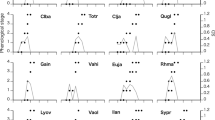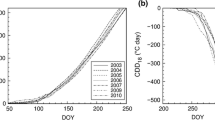Abstract
Dynamic features of shoot phenology including leaf emergence and leaf fall, and leaf life span for eleven evergreen broad-leaved tree species were investigated in a warm-temperate rain forest in Mount Kiyosumi, central Japan. All species had periodic leaf emergence or flushing pattern, and were classified into two types; single and multiple flush and only one species, Eurya japonica, represented the latter type and the rest had single flush in spring. The single flush type can further be subdivided into two groups according to their duration of shoot growth; short and long flush. Seasonal patterns of leaf fall were categorized into four; unimodal, bimodal, broad unimodal, and multimodal type though they were not fixed pattern. The leaf emergence and leaf fall patterns were correlated for the eleven species, and five phenological types were categorized. Four of them were the single flush types, i.e., short flush of leaf emergence with unimodal leaffall (SSU) type of Castanopsis sieboldii and Quercus salicina, short flush with bimodal leaf fall (SSB) type of Quercus acuta, Machilus thunbergii, Neolitsea sericea, and Cinnamomum japonicum, long flush with bimodal leaffall (SLB) type of Myrsine seguinii, and long flush with broad unimodal leaffall (SLR) type of Symplocos prunifolia, Cleyera japonica, and Illicium anisatum. The multiple flush type is only one species, Eurya japonica, and it had multimodal leaffall pattern (MM type). The phenological pattern varied in relation to leaf life span, leaf size, and tree habit. Leaf life span ranged from 1.1 to 5.8 yr. The short flush species or SSU and SSB types were all canopy or subcanopy trees, and the former had short and the latter had long leaf life spans. The long flush species were all microphyllous small trees, and SLB type had a relatively long leaf life span in understory, SLR type had a long leaf life span in understory or in open habitat and/or forest gap as a pioneer tree. MM type had a long leaf life span and colonizing species in open habitat but they can survive in understory as well. The phenological attributes of evergreen trees were well corresponded to the ecological guild of the tree in both forest structure and successional stage, and were also constrained by phylogenetic groups.
Similar content being viewed by others
References
Addicott, F. T. 1978. Abscission strategies in the behavior of tropical trees. Pp. 381-398. In: Tomlinson, P. B. & Zimmermann, M. H. (eds) 1978. Tropical Trees as Living Systems. Cambridge Univ. Press.
Addicott, F. T. 1991. Abscission: shedding of parts. Pp. 273-300. In: Raghavendra, A. S. (ed.) Physiology of Trees. Academic Press. NY.
Bazazz, F. A. & Pickett, S. T. A. 1980. Physiological ecology of tropical succession: a comparative review. Ann. Rev. Ecol. Syst. 11: 287-310.
Bentley, B. L. 1979. Longevity of individual leaves in a tropical rainforest understory. Ann. Bot. 43: 119-121.
Bond, T. E. T. 1942. Studies in the vegetative growth and anatomy of the tea plant (Camellia theaLink.) with special reference to the phloem. I. The flush shoot. Ann. Bot. (N.S.) 24: 607-629.
Boojh, R. & Ramakrishnan, P. S. 1982a. Growth strategy of trees related to successional status I. Architecture and extension growth. Forest Ecol. Management 4: 359-374.
Boojh, R. & Ramakrishnan, P. S. 1982b. Growth strategy of trees related to successional status II. Leaf dynamics. Forest Ecol. Management 4: 375-386.
Borchert, R. 1991. Growth periodicity and dormancy. Pp. 221-245. In: Raghavendra, A. S. (ed.) Physiology of Trees. Academic Press. NY.
Brown, C. L. 1971. Primary growth. Pp. 1-66. In: Zimmermann, M. H. & Brown, C. L. (eds.) Trees. Structure and function. Springer-Verlag, NY.
Dhaila, S., Singh, S. P., Negi, G. C. S. & Rawat, Y. S. 1995. Shoot growth phenology of co-existing evergreen and deciduous species in an oak forest. Ecol. Res. 10: 151-159.
Grubb, P. J. 1977. Control of forest growth and distribution on wet tropical mountains: with special reference to mineral nutrition. Ann. Rev. Ecol. Syst. 8: 83-107.
Grubb, P. J., Grubb, E. A. A. & Miyata, I. 1975. Leaf structure and function in evergreen trees and shrubs of Japanese warm temperate rain forest. I. The structure of the lamina. Botanical Magazine, Tokyo 88: 197-211.
Hallé, F., Oldeman, R. A. A. & Tomlinson, P. B. 1978. Tropical Trees and Forests. Springer-Verlag, Berlin.
Holttum, R. E. 1953. Evolutionary trends in an equatorial climate. Evolution. Symposia of the Society for Experimental Biology, No. VII: 159-173.
Kabaya, H. & Suzuki, S. 1992. Phenology of tree species by measuring litter fall I. Patterns of leaf fall of evergreen oak (Quercus acuta) in two stands of the University Forest in Chiba, University of Tokyo. Bulletin of the Tokyo University Forests, No. 88: 135- 148 (in Japanese with English summary).
Kikuzawa, K. 1983. Leaf survival of woody plants in deciduous broad-leaved forests. 1. Tall trees. Can. J. Bot. 61: 2133-2139.
Kikuzawa, K. 1984. Leaf survival of woody plants in deciduous broad-leaved forests. 2. Small trees and shrubs. Can. J. Bot. 62: 2551-2556.
Koriba, K. 1958. On the periodicity of tree-growth in the tropics, with reference to the mode of branching, the leaf-fall, and the formation of the resting bud. Gard. Bull. Singapore 17: 11-81.
Kozlowski, T. T. 1971. Growth and Development of Trees. Volume I. Seed germination, ontogeny, and shoot growth. Academic Press. NY. 443 pp.
Lee, I. S., Ohsawa, M., & Numata, M. 1992. Litterfall, accumulation and turnover of nutrients in the forest floor of warm-temperate forests of central Japan. Nat. Hist. Res. 2: 29-37.
Leigh, Jr. E. G. 1975. Structure and climate in tropical rain forest. Ann. Rev. Ecol. Syst. 6: 67-86.
Longman, K. A. & Jenik, J. 1987. Tropical Forest and its Environment. 2nd ed. Longman Scientific & Technical Limited.
Lowman, M. D. 1992. Leaf growth dynamics and herbivory in five species of Australian rain-forest canopy trees. J. Ecol. 80: 433- 447.
Maruyama, K. 1978. Shoot elongation characteristics and phenological behavior of forest trees in natural beech forest. Ecological studies on natural beech forest (32). Bulletin of the Niigata University Forests No. 11: 1-30 (in Japanese with English summary).
Medway, L. 1972. Phenology of a tropical rain forest in Malaya. Biol. J. Linn. Soc. 4: 117-146.
Nishioka, M. & Kirita, H. 1978. Litterfall. In Kira, T., Ono, Y. & Hosokawa, T. eds. Biological Production in a Warm-Temperate Evergreen Oak Forest of Japan. JIBP Synthesis Vol. 18: 231-238. University of Tokyo Press. Tokyo. 288 pp.
Ohsawa, M. 1990. An interpretation of latitudinal patterns of forest limits in south and east Asian Mountains. J. of Ecol. 78: 326-339.
Ohsawa, M. 1991. Structural comparison of tropical montane rain forests along latitudinal and altitudinal gradients in south and east Asia. Vegetatio 97: 1-10.
Ohsawa, M. 1993. Latitudinal pattern of mountain vegetation zonation in southern and eastern Asia. J. Vegetation Sci. 4: 13-18.
Ohsawa, M. 1995a. Latitudinal comparison of altitudinal changes in forest structure, leaf-type, and species richness in humid monsoon Asia. Vegetatio 121: 3-10.
Ohsawa, M. 1995b. The montane cloud forest and its gradational changes in southeast Asia. In: Hamilton, L. S., Juvik, J. O. & Scatena, F. N. (eds) Tropical Montane Cloud Forests. Ecological Studies. Vol. 110: 254-265. Springer, NY.
Ohsawa, M., Shakya, P. R., & Numata, M. 1986. Distribution and succession of west Himalayan forest types in the eastern part of the Nepal Himalaya. Mountain Res. Develop. 6: 143-157.
Ohtsuka, T., Sakura, T. & Ohsawa, M. 1993. Early herbaceous succession along a topographical gradient on a forest clear-felling sites inmountainous terrain, central Japan. Ecol. Res. 8: 329-340.
Ozaki, K. & Ohsawa, M. 1995. Successional change of forest pattern along topographical gradients in warm-temperate mixed forests in Mt. Kiyosumi, central Japan. Ecol. Res. 10: 223-234.
Putz, F. E. 1979. A seasonality in Malaysian tree phenology. The Malaysian Forester 42: 1-24.
Richards, P.W. 1952. The Tropical Rain Forest. An Ecological Study. Cambridge Univ. Press. Cambridge. 450 pp.
Sakai, A. & Ohsawa, M. 1993. Vegetation pattern and microtopography on a landslide scar of Mt. Kiyosumi, central Japan. Ecol. Res. 8: 47-56.
Shukla, R. P. & Ramakrishnan, P. S. 1982. Phenology of trees in a sub-tropical humid forest in north-eastern India. Vegetatio 49: 103-109.
Shukla, R. P.& Ramakrishnan, P. S. 1984. Leaf dynamics of tropical trees related to successional status. New Phytol. 97: 697-706.
Shukla, R. P. & Ramakrishnan, P. S. 1986. Architecture and growth strategies of tropical trees in relation to successional status. J. Ecol. 74: 33-46.
Singh, J. S. & Singh, S. P. 1992. Forests of Himalaya. Structure, functioning and impact of man. Gyanodaya Prakashan. Nainital, India.
Suehiro, K. & Kameyama, K. 1992. Leaf age composition of evergreen broadleaved trees. Jpn. J. Ecol. 42: 137-147 (in Japanese with English summary).
Tange, T., Matsumoto, Y., Mashimo, I. & Sakura, T. 1989. Courses of height growth of Cryptomeria japonicatrees planted on a slope. Comparison among the near ridge, the mid-slope and the near bottom in the Tokyo University Forest in Chiba. Bulletin of the Tokyo University Forest 81: 39-51 (in Japanese with English summary).
TUFC (Tokyo University Forest in Chiba) 1987. Meteorological data of the Tokyo University Forest in Chiba (1975-1984). Miscellaneous Information, Tokyo University Forests 25: 49-59 (in Japanese).
TUFC (Tokyo University Forest in Chiba). 1994, 1995. Ann. Report Meteorol. Data Kiyosumi in 1994, 1995. TUFC.
Ueda, S. & Tsutsumi, T. 1977. Litterfall of artificial forest of Chamaecyparis obtusaand of natural evergreen broad leaved forest dominated by Machilus thunbergii. Bull. University Forest of Kyoto University. No. 49: 30-40 in (in Japanese with English summary).
Van Schaik, C. P. 1986. Phenological changes in a Sumatran rain forest. J. Tropical Ecol. 2: 327-347.
Whitmore, T. C. 1984. Tropical Rain Forests of the Far East, 2nd ed. Oxford University Press, Oxford.
Author information
Authors and Affiliations
Rights and permissions
About this article
Cite this article
Nitta, I., Ohsawa, M. Leaf dynamics and shoot phenology of eleven warm-temperate evergreen broad-leaved trees near their northern limit in central Japan. Plant Ecology 130, 71–88 (1997). https://doi.org/10.1023/A:1009735709258
Issue Date:
DOI: https://doi.org/10.1023/A:1009735709258




